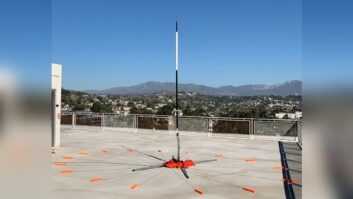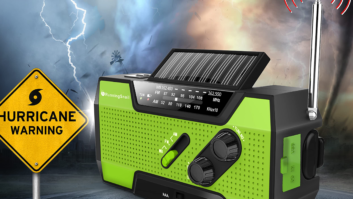Emergency Radio
Jun 1, 2006 12:00 PM, by Anders Madsen

The firefighter who enters a burning high-rise already has a dangerous job. Moving through smoke and darkness to a stairwell and, against traffic, upward toward the source of the fire, he can use all the information he can get to make his job safer. Even though police outside can see that the building is collapsing, they can’t tell him. Police radios can’t talk to fire radios.
A storm hits. Cell towers are down, and the same lack of communication exists among police, fire and rescue personnel. The management of the emergency is severely hampered because there is no way to coordinate activities. The first 72 hours, when it would be crucial to deliver information, are marked by a complete lack of effective communication.
As recent events along the Gulf Coast and elsewhere have shown, the job of creating effective emergency communications management systems is not yet done.
Critical information systems
The federal government is developing ways to overcome the shortcomings exposed by Hurricane Katrina, including the inability of interagency radio systems to interoperate. Equipment suppliers are anxious to provide hardware solutions to communications shortfalls, but proposed approaches offer advantages and disadvantages that complicate the decision-making process for local officials.

A personal alert receiver from Viaradio.
Most mature among these technologies, the familiar-to-all Emergency Alert System has served for decades to warn of threats including fires, floods and approaching storms. Using the existing broadcast infrastructure, EAS announcements come over the air to radios and TVs and are played by every active receiver in the service areas of the transmitters being used. By their nature, these one-way alerts are broad and nonspecific, and cannot be sent to a select audience.
Newer RBDS and satellite-based alerting systems offer the advantage of targeted messaging, optionally tailoring messages to specific individuals or groups. From a central command, pertinent information can be sent to rescuers, relief centers, police and fire, and, given the right equipment, to the general population. In the case of satellite systems, the receipt of the message can be acknowledged back to the control center, and a log kept of the time each message is seen. The advantages of targeted messaging are clear. As the disaster progresses, responses can be directed, and meetings can be arranged among critical personnel to share information and to determine how to adapt to changes on the ground.
The use of RBDS to send emergency text messages has been explored in Europe, where Radio Data Service first saw widespread use in consumer receivers. From Germany, a company called 2wcom has marketed an RBDS-based system that depends on supplying special FM radios to businesses and households in high-risk areas. A constantly searching RBDS receiver sounds an alarm or presents flashing lights when an emergency message of sufficient priority enters the system. The largest user of RBDS alert technology, the Swedish nuclear power industry, has issued receivers to residents of areas around power plants.
2wcom’s U.S. subsidiary is Viaradio in Melbourne, FL. President Bill Marriott is rolling out the 2wcom system for local SBE chapters and displayed the system at NAB2006. The next generation 2wcom products will introduce addressability, with multiple priority levels for messages, which allows low priority messages to be sent silently, or high priority messages that place the receiver to go into an alert mode, complete with sirens and lights, if desired. With the waking tabletop radio available today, Marriott sees the eventual incorporation of receiver chips in cell phones and TVs as �a great idea.� But �the problem with something like that is that to get suitable market penetration may take many, many years.�
Communication Laboratories (Comlabs), also of Melbourne, FL, offers a hybrid Internet/satellite-based system that connects tiers of hierarchy in federal, state, county and municipal governments and private industry. Depending on who knows first of the emergency, an initial EAS message can be issued via TCP/IP to its uplink and down using its product, Emnet (Emergency management net), to a command center, to targeted groups or to every Emnet user in the state. Broadcasters on the system can go to air with the news, and the delays and lack of participation associated with daisy-chain issues, common to EAS, can be alleviated. Acknowledging a lack of satellite reception inside buildings, the company uses satellite receiver cards built into the computers they manufacture to put the alert onto the client site’s LAN and its computers. Delivery times are measured in seconds to as many as thousands of sites.
States weigh the options
Especially along the Gulf Coast, officials in the states hit hardest by Katrina are at the front of the line to assess these competing technologies. Mississippi, the first to adopt the new technology statewide, has selected RBDS-based equipment developed by Global Security Systems (GSS) of Jackson, MS. According to Vice President Matthew Straeb, GSS uses proprietary software to deliver text messages to receiver/display devices. These devices receive RBDS signals sent by FM stations, the assumption being that at least some FM towers will survive a natural or man-made disaster. The $1.6 million contract was granted in early March after about six months of investigation and deliberation.

GSS offers several personal alert monitors.
Regarding the selection of RBDS technology over satellite and over statewide integration of two-way radios, Mississippi’s Program Review Administrator Todd Frier said, �Satellite phones are expensive. It’s just not feasible to give every firefighter and all law enforcement personnel a satellite phone.� The proposal to integrate radios is a $200 million-plus idea, projected to take seven to eight years to complete. Right or wrong, Frier said, it’s not a solution for today.
Mississippi Director of Homeland Security Ed Worthington describes his mission as that of building a backbone, a basic system that can be used in the near term, and can be expanded going forward. The first stage of implementation of the state’s new RBDS system involves giving specialized receivers (supplied by GSS) to 100 people along the coast, in the lower six counties of the state. These critically chosen individuals will be able to receive text messages right away, and the plan allows for additional receivers to be purchased by local counties and municipalities as their budgets allow. Later, assuming that the technology is embraced, once the receiver chips are built into cell phones, all responders will have access to cell phone delivery of emergency text messages.
GPS allows directed reception
Because the capability of global positioning (GPS) is expected in any new system, messages can be sent not only to a select individual or group (through normal addressing), but also to all recipients in a defined geographic area using GPS. In addition, the receiver crop could be grown in the future to include home appliances � microwave ovens with receiver chips inside could display alerts, as could smoke detectors or any other devices with digital displays. Given the development of a sizable installed base of receiving devices, each county’s emergency operations managers could make the decision to buy message-generating equipment for about $20,000 � considered inexpensive for a capability of such magnitude.
Two of the coastal counties in Mississippi are considering placing a receiver in every home, at a cost of less than $20 each. Oncoming weather would trigger a message, tailored for the emergency, sent to all receivers in a designated area. As of this writing, Mississippi is reported to be the first state to pursue this objective to this well-defined point.
During Katrina, Mississippi suffered spotty or no communication for the first 48 to 72 hours post-landfall. �If we had had this capability then,� said Worthington, �we would have been able to send a message day one, three hours after the storm had passed through, and ask the fire chiefs, police chiefs, sheriffs, to meet at a certain location at a certain time, and be able to provide us with whatever their needs might be. Right now we don’t have that capability and didn’t during Katrina. We will have that starting June 1.�
Flying between the layers
Up to now, push-to-talk radio systems have allowed agencies to overcome a loss of cell towers, but although many local two-way systems maintained their integrity during Katrina, not all of them interoperated with each other. Agencies often had some form of communication with their own people, but not with other agencies. The result seemed to make the crisis much worse than might have been the case had communication been more effective among police, fire and rescue personnel.

From emergency notification to message distribution, all levels of authority depend on a robust communication chain to move information as required. Click here to enlarge this image.
In Mississippi, the experience has guided Worthington’s effort to design new communications methods. During the storm’s aftermath, he saw that satellite radios continued to work �magnificently.� Unfortunately, there was only one state law enforcement agency that had them, so a sergeant with the Mississippi Department of Wildlife and Fisheries, the lucky agency, was parked outside Worthington’s Homeland Security office relaying messages for days.
�There is no one panacea for communications. It has to be a layered approach,� said Worthington. �I’m also trying to make sure that that satellite radio capability is established in those lower six counties.�
�Links
- 2wcom
www.2wcom.com - Comlabs Emnet
www.comlabs.com - GSS
www.gssnet.us - Viaradio
www.viaradio.comIf Mississippi also finds the money to integrate a statewide two-way radio system, Worthington is determined that the RBDS-based GSS system will remain as one of the communication layers in the state. �It’s one thing to be able to contact first responders; it’s another thing to alert citizens. How do you alert your population? The potential here is to have this device in every home, so that they also will be protected.�Madsen, a freelance author, is a marketing consultant to broadcast equipment manufacturers.












